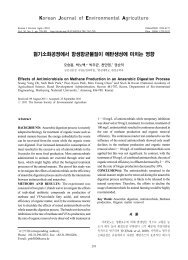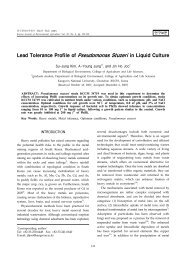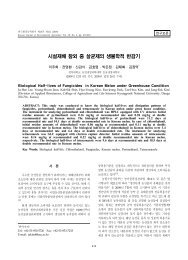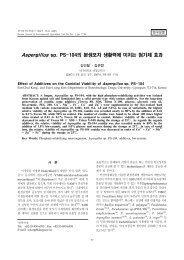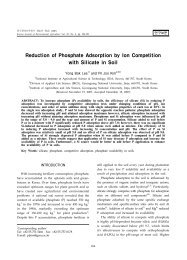Determination of Abamectin Residue in Paprika by High ...
Determination of Abamectin Residue in Paprika by High ...
Determination of Abamectin Residue in Paprika by High ...
Create successful ePaper yourself
Turn your PDF publications into a flip-book with our unique Google optimized e-Paper software.
362<br />
Wen-M<strong>in</strong>g Xie, Kwang-Yong Ko, Sung-Hun Kim, Hee-Ra Chang, and Kyu-Seung Lee<br />
control samples to assess the analytical method proposed<br />
for AVMs residues. Prior to extraction, the series<br />
<strong>of</strong> the control samples were fortified with AVMs standard<br />
solution <strong>in</strong> acetonitrile at specified concentrations<br />
accord<strong>in</strong>g to the MRL <strong>in</strong> pepper and l<strong>in</strong>ear range.<br />
After stand<strong>in</strong>g for 2 hours, the analytical procedures<br />
mentioned above were carried out to produce recovery<br />
data.<br />
Method evaluation<br />
B 1a<br />
RESULTS AND DISCUSSION<br />
AVMs and the degradation compound 8, 9-Z-AVM<br />
were determ<strong>in</strong>ed <strong>in</strong> paprika us<strong>in</strong>g the HPLC<br />
method with fluorescence detector. The Fig. 2 shows<br />
the UV absorption spectra <strong>of</strong> AVM B 1a and fluorescence<br />
spectra <strong>of</strong> AVM B 1a derivative. The absorbance spectra<br />
were shown to exhibit absorbance maxima at 244 nm<br />
for AVMs and 242 nm for 8, 9-Z-AVM B 1a. Accord<strong>in</strong>g<br />
to the excitation and emission spectra <strong>of</strong> AVM, 365<br />
nm and 470 nm were chosen as excitation and emission<br />
wavelength to get the highest detection sensitivity.<br />
The RP-HPLC system used for this method provided<br />
an excellent separation for all three compounds<br />
show<strong>in</strong>g basel<strong>in</strong>e separation. The representative chromatograms<br />
<strong>of</strong> a mixture <strong>of</strong> these three compounds and<br />
their derivatives are shown <strong>in</strong> Fig.3. The derivative<br />
formation was <strong>in</strong>stantaneous 17) . When the aged reagents<br />
were used, the yield was decreased and an extra peak<br />
appeared 6) . Us<strong>in</strong>g acetonitrile-water (96:4, v/v) as mobile<br />
phase, derivatives eluted after 8.0 and 9.7 m<strong>in</strong>utes<br />
and no <strong>in</strong>terference was found <strong>in</strong> paprika extracts.<br />
The standard curves for these AVM B 1a+8, 9-AVM<br />
B 1a and AVM B 1b exhibited excellent l<strong>in</strong>earity over the<br />
follow<strong>in</strong>g concentration ranges: AVM B 1a+8, 9-AVM<br />
B 1a, 11.97-1197 ng/mL, AVM B 1b, 1-96.6 ng/mL. The<br />
l<strong>in</strong>ear ranges were selected on the basis <strong>of</strong> expected<br />
residue concentration and the MRL <strong>of</strong> ABM <strong>in</strong> paprika.<br />
The l<strong>in</strong>ear correlation coefficients <strong>of</strong> calibration<br />
curves for AVM B 1a+8, 9-Z-AVM B 1a and AVM B 1b<br />
were 0.999 and 0.998, respectively.<br />
<strong>Paprika</strong> samples spiked at two levels (20 and 200<br />
μg/kg) <strong>of</strong> ABM were analyzed three times us<strong>in</strong>g the<br />
prescribed procedure for extraction, clean-up and derivatization.<br />
The results, summarized <strong>in</strong> Table 1, <strong>in</strong>dicate<br />
that the recoveries, ranged from 93% to 115%, and the<br />
repeatability, less than 10% ,was satisfactory for trace<br />
residue analysis.<br />
The lowest level <strong>of</strong> quantitation for AVMs <strong>in</strong> paprika<br />
was calculated as 2 μg/kg for AVM B1a, <strong>in</strong>clud<strong>in</strong>g<br />
8,9-Z-AVM B 1a ,with a 5 g spik<strong>in</strong>g sample portion.<br />
Consider<strong>in</strong>g the MRLs <strong>of</strong> AVMs <strong>in</strong> most vegetables,<br />
range from 10 to 50<br />
μg/kg, the sensitivity was high<br />
enough for rout<strong>in</strong>e residue analysis <strong>of</strong> fruit and vegetable<br />
samples.<br />
Term<strong>in</strong>al residue <strong>of</strong> AVMs <strong>in</strong> the field experiment<br />
ABM has been l<strong>in</strong>ked to a wide spectrum <strong>of</strong> human<br />
health hazards, rang<strong>in</strong>g from short-term impacts to<br />
chronic impacts. Chronic health effects may occur years<br />
mV<br />
0 100 200 300 400<br />
A<br />
8 . 083<br />
B<br />
9.708<br />
Standard<br />
Sample<br />
B lank<br />
0 2 4 6 8 10 12 14<br />
M<strong>in</strong>ute<br />
Fig. 2. UV absorption spectra <strong>of</strong> avermect<strong>in</strong> (AVM) and<br />
Fig. 3. Chromatograms <strong>of</strong> AVM derivatives <strong>in</strong> standard<br />
fluorescence spectra <strong>of</strong> AVM derivative.<br />
and sample extract. A: AVM B 1b, , B: AVM B 1a+8, 9-Z-<br />
A: UV absorption spectrum <strong>of</strong> AVM B1. B and C: excitation<br />
AVM B 1a.<br />
and emission spectrum <strong>of</strong> AVM B1 derivative HPLC conditions: RP Symmetry C 18 sta<strong>in</strong>less column (3.9<br />
mm i.d.×150mm, Waters Associates). The mobile phase,<br />
consist<strong>in</strong>g <strong>of</strong> water <strong>in</strong> acetonitrile (4+96, v/v), was pumped<br />
at the total flow <strong>of</strong> 1.2 mL/m<strong>in</strong>



